SUBARU OUTBACK 2007 4.G Owner's Guide
Manufacturer: SUBARU, Model Year: 2007, Model line: OUTBACK, Model: SUBARU OUTBACK 2007 4.GPages: 442, PDF Size: 13.39 MB
Page 31 of 442
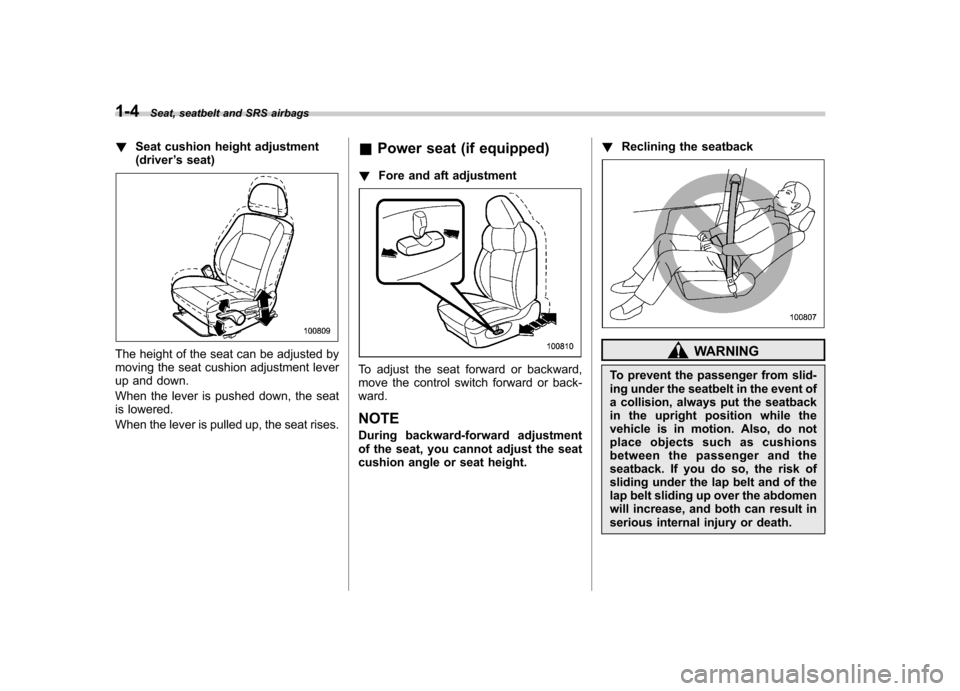
1-4Seat, seatbelt and SRS airbags
!Seat cushion height adjustment (driver ’s seat)
The height of the seat can be adjusted by
moving the seat cushion adjustment lever
up and down.
When the lever is pushed down, the seat
is lowered.
When the lever is pulled up, the seat rises. &
Power seat (if equipped)
! Fore and aft adjustment
To adjust the seat forward or backward,
move the control switch forward or back-ward. NOTE
During backward-forward adjustment
of the seat, you cannot adjust the seat
cushion angle or seat height. !
Reclining the seatback
WARNING
To prevent the passenger from slid-
ing under the seatbelt in the event of
a collision, always put the seatback
in the upright position while the
vehicle is in motion. Also, do not
place objects such as cushions
between the passenger and the
seatback. If you do so, the risk of
sliding under the lap belt and of the
lap belt sliding up over the abdomen
will increase, and both can result in
serious internal injury or death.
Page 32 of 442
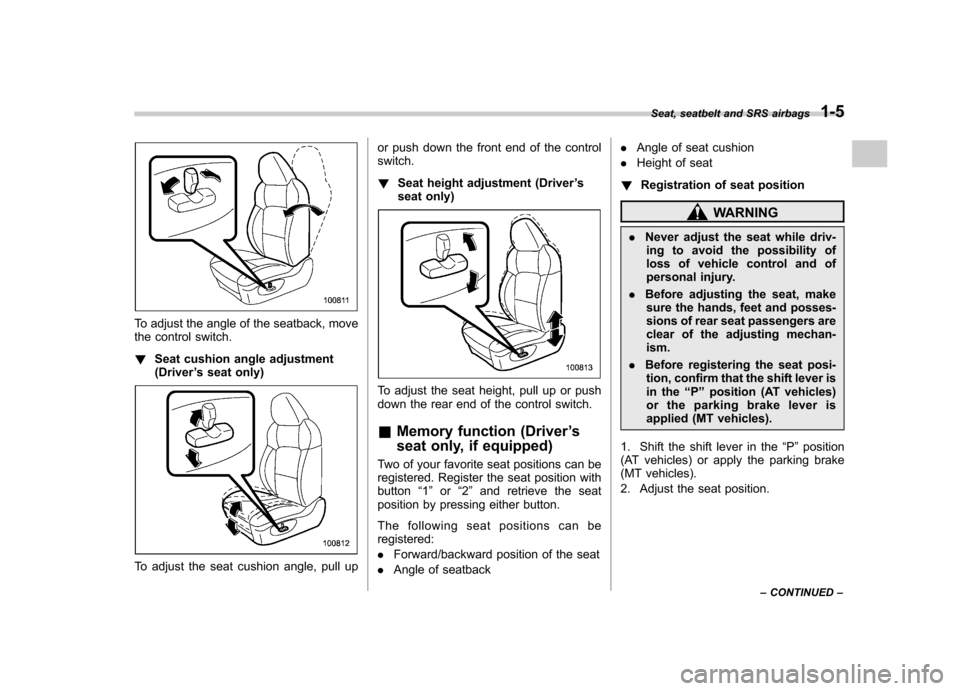
To adjust the angle of the seatback, move
the control switch. !Seat cushion angle adjustment (Driver ’s seat only)
To adjust the seat cushion angle, pull up or push down the front end of the control switch. !
Seat height adjustment (Driver ’s
seat only)
To adjust the seat height, pull up or push
down the rear end of the control switch. & Memory function (Driver ’s
seat only, if equipped)
Two of your favorite seat positions can be
registered. Register the seat position withbutton “1 ” or “2 ” and retrieve the seat
position by pressing either button.
The following seat positions can be registered: . Forward/backward position of the seat
. Angle of seatback .
Angle of seat cushion
. Height of seat
! Registration of seat position
WARNING
. Never adjust the seat while driv-
ing to avoid the possibility of
loss of vehicle control and of
personal injury.
. Before adjusting the seat, make
sure the hands, feet and posses-
sions of rear seat passengers are
clear of the adjusting mechan-ism.
. Before registering the seat posi-
tion, confirm that the shift lever is
in the “P ” position (AT vehicles)
or the parking brake lever is
applied (MT vehicles).
1. Shift the shift lever in the “P ” position
(AT vehicles) or apply the parking brake
(MT vehicles).
2. Adjust the seat position. Seat, seatbelt and SRS airbags
1-5
– CONTINUED –
Page 33 of 442
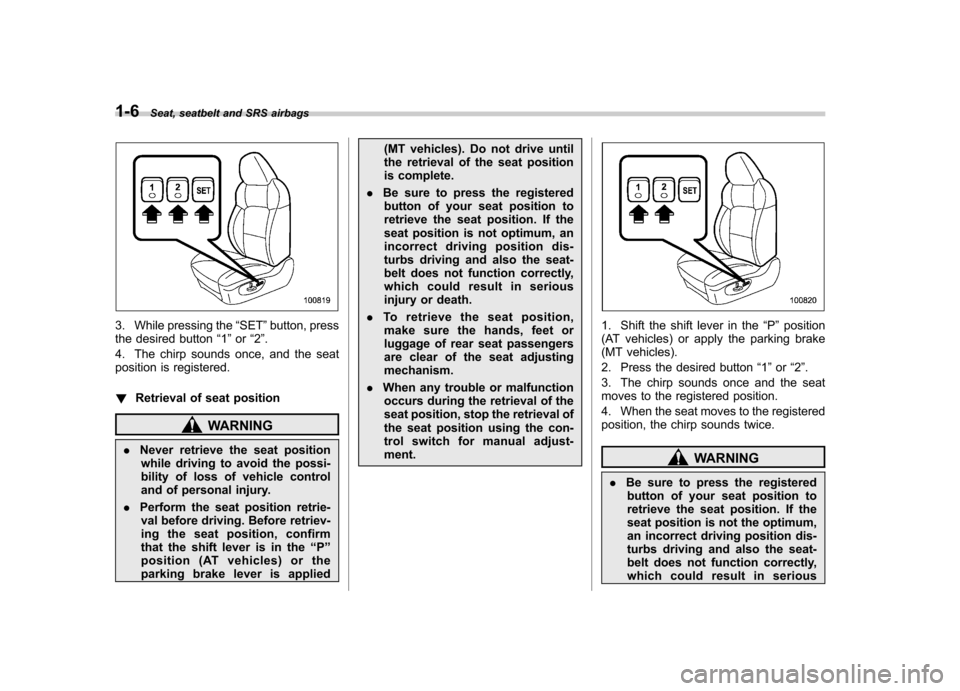
1-6Seat, seatbelt and SRS airbags
3. While pressing the “SET ”button, press
the desired button “1 ” or “2 ”.
4. The chirp sounds once, and the seat
position is registered. ! Retrieval of seat position
WARNING
. Never retrieve the seat position
while driving to avoid the possi-
bility of loss of vehicle control
and of personal injury.
. Perform the seat position retrie-
val before driving. Before retriev-
ing the seat position, confirm
that the shift lever is in the “P ”
position (AT vehicles) or the
parking brake lever is applied (MT vehicles). Do not drive until
the retrieval of the seat position
is complete.
. Be sure to press the registered
button of your seat position to
retrieve the seat position. If the
seat position is not optimum, an
incorrect driving position dis-
turbs driving and also the seat-
belt does not function correctly,
which could result in serious
injury or death.
. To retrieve the seat position,
make sure the hands, feet or
luggage of rear seat passengers
are clear of the seat adjustingmechanism.
. When any trouble or malfunction
occurs during the retrieval of the
seat position, stop the retrieval of
the seat position using the con-
trol switch for manual adjust-ment.
1. Shift the shift lever in the “P ” position
(AT vehicles) or apply the parking brake
(MT vehicles).
2. Press the desired button “1 ” or “2 ”.
3. The chirp sounds once and the seat
moves to the registered position.
4. When the seat moves to the registered
position, the chirp sounds twice.
WARNING
. Be sure to press the registered
button of your seat position to
retrieve the seat position. If the
seat position is not the optimum,
an incorrect driving position dis-
turbs driving and also the seat-
belt does not function correctly,
which could result in serious
Page 34 of 442
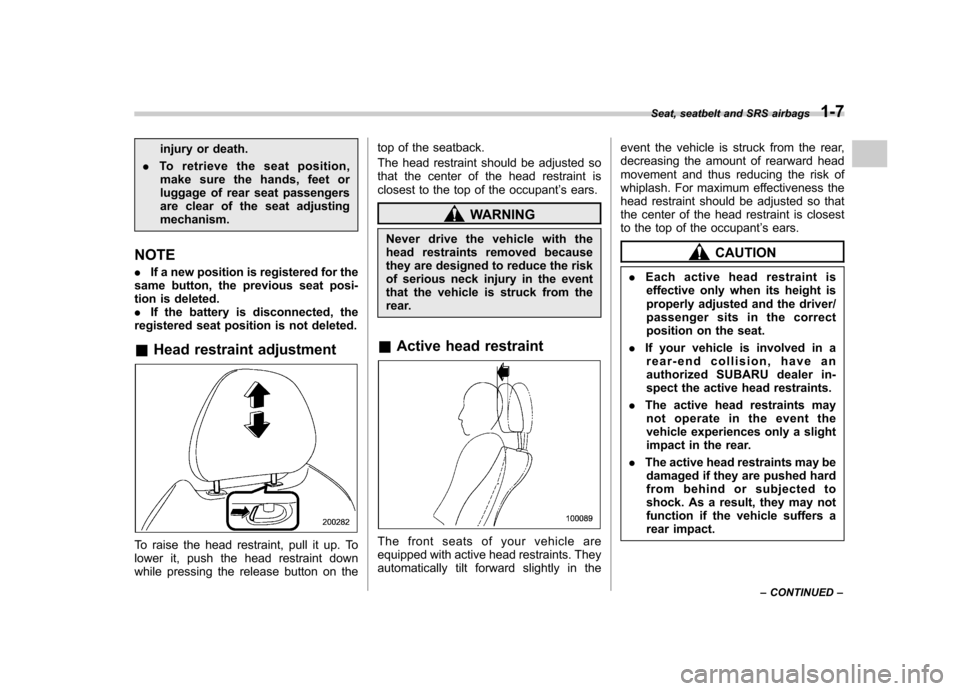
injury or death.
. To retrieve the seat position,
make sure the hands, feet or
luggage of rear seat passengers
are clear of the seat adjustingmechanism.
NOTE . If a new position is registered for the
same button, the previous seat posi-
tion is deleted.. If the battery is disconnected, the
registered seat position is not deleted. & Head restraint adjustment
To raise the head restraint, pull it up. To
lower it, push the head restraint down
while pressing the release button on the top of the seatback.
The head restraint should be adjusted so
that the center of the head restraint is
closest to the top of the occupant
’s ears.
WARNING
Never drive the vehicle with the
head restraints removed because
they are designed to reduce the risk
of serious neck injury in the event
that the vehicle is struck from the
rear.
& Active head restraint
The front seats of your vehicle are
equipped with active head restraints. They
automatically tilt forward slightly in the event the vehicle is struck from the rear,
decreasing the amount of rearward head
movement and thus reducing the risk of
whiplash. For maximum effectiveness the
head restraint should be adjusted so that
the center of the head restraint is closest
to the top of the occupant
’s ears.
CAUTION
. Each active head restraint is
effective only when its height is
properly adjusted and the driver/
passenger sits in the correct
position on the seat.
. If your vehicle is involved in a
rear-end collision, have an
authorized SUBARU dealer in-
spect the active head restraints.
. The active head restraints may
not operate in the event the
vehicle experiences only a slight
impact in the rear.
. The active head restraints may be
damaged if they are pushed hard
from behind or subjected to
shock. As a result, they may not
function if the vehicle suffers a
rear impact. Seat, seatbelt and SRS airbags
1-7
– CONTINUED –
Page 35 of 442
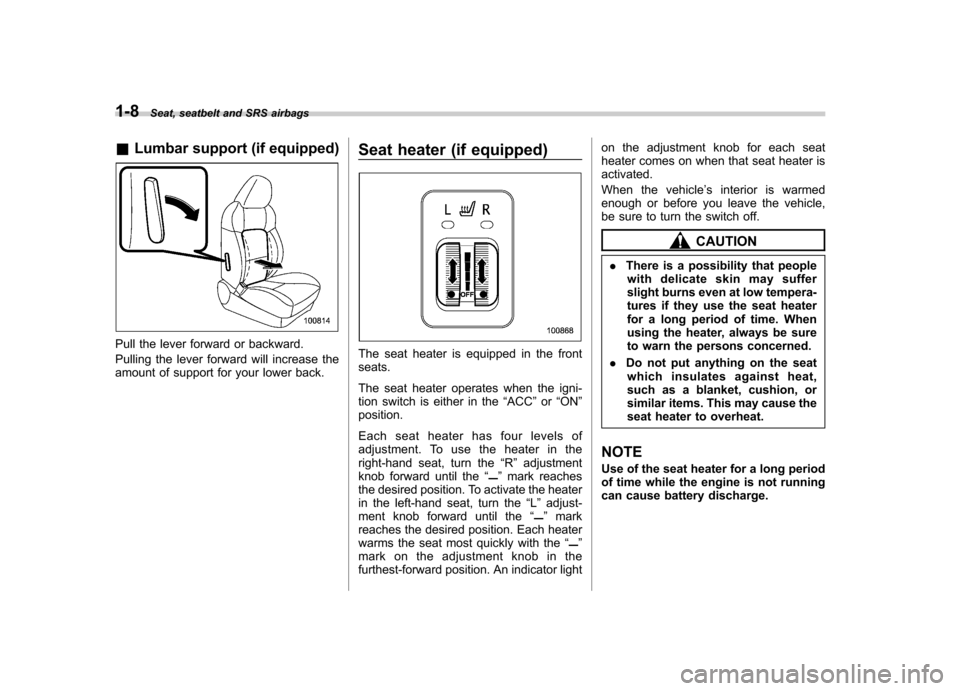
1-8Seat, seatbelt and SRS airbags
&Lumbar support (if equipped)
Pull the lever forward or backward.
Pulling the lever forward will increase the
amount of support for your lower back. Seat heater (if equipped)The seat heater is equipped in the front seats.
The seat heater operates when the igni-
tion switch is either in the
“ACC ”or “ON ”
position.
Each seat heater has four levels of
adjustment. To use the heater in the
right-hand seat, turn the “R ” adjustment
knob forward until the “
”mark reaches
the desired position. To activate the heater
in the left-hand seat, turn the “L ” adjust-
ment knob forward until the “
”mark
reaches the desired position. Each heater
warms the seat most quickly with the “
”
mark on the adjustment knob in the
furthest-forward position. An indicator light on the adjustment knob for each seat
heater comes on when that seat heater isactivated.
When the vehicle
’s interior is warmed
enough or before you leave the vehicle,
be sure to turn the switch off.
CAUTION
. There is a possibility that people
with delicate skin may suffer
slight burns even at low tempera-
tures if they use the seat heater
for a long period of time. When
using the heater, always be sure
to warn the persons concerned.
. Do not put anything on the seat
which insulates against heat,
such as a blanket, cushion, or
similar items. This may cause the
seat heater to overheat.
NOTE
Use of the seat heater for a long period
of time while the engine is not running
can cause battery discharge.
Page 36 of 442
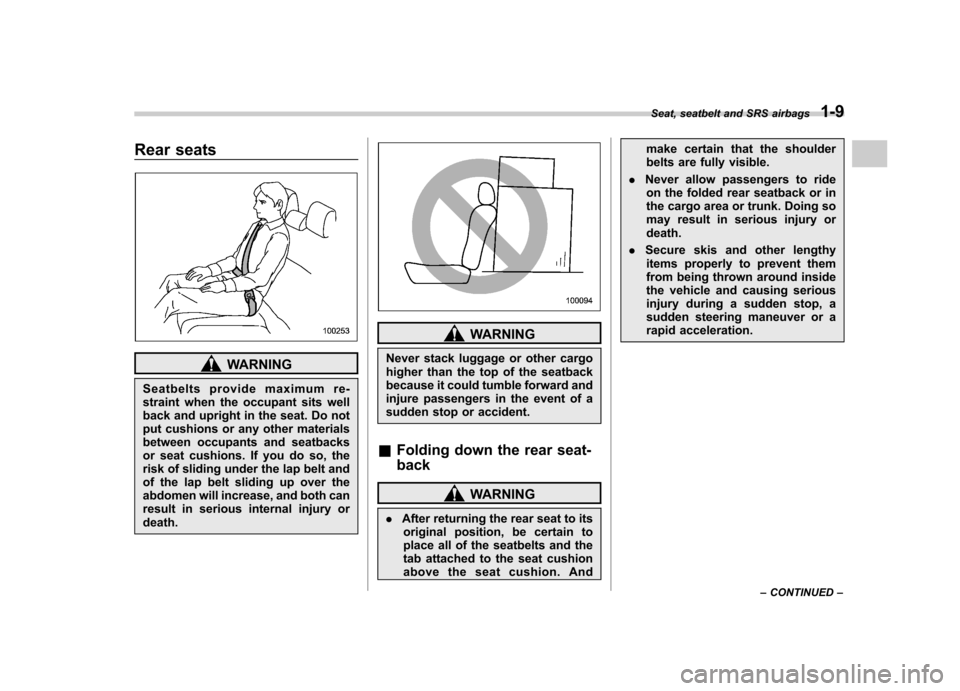
Rear seats
WARNING
Seatbelts provide maximum re-
straint when the occupant sits well
back and upright in the seat. Do not
put cushions or any other materials
between occupants and seatbacks
or seat cushions. If you do so, the
risk of sliding under the lap belt and
of the lap belt sliding up over the
abdomen will increase, and both can
result in serious internal injury ordeath.
WARNING
Never stack luggage or other cargo
higher than the top of the seatback
because it could tumble forward and
injure passengers in the event of a
sudden stop or accident.
& Folding down the rear seat- back
WARNING
. After returning the rear seat to its
original position, be certain to
place all of the seatbelts and the
tab attached to the seat cushion
above the seat cushion. And make certain that the shoulder
belts are fully visible.
. Never allow passengers to ride
on the folded rear seatback or in
the cargo area or trunk. Doing so
may result in serious injury ordeath.
. Secure skis and other lengthy
items properly to prevent them
from being thrown around inside
the vehicle and causing serious
injury during a sudden stop, a
sudden steering maneuver or a
rapid acceleration. Seat, seatbelt and SRS airbags
1-9
– CONTINUED –
Page 37 of 442
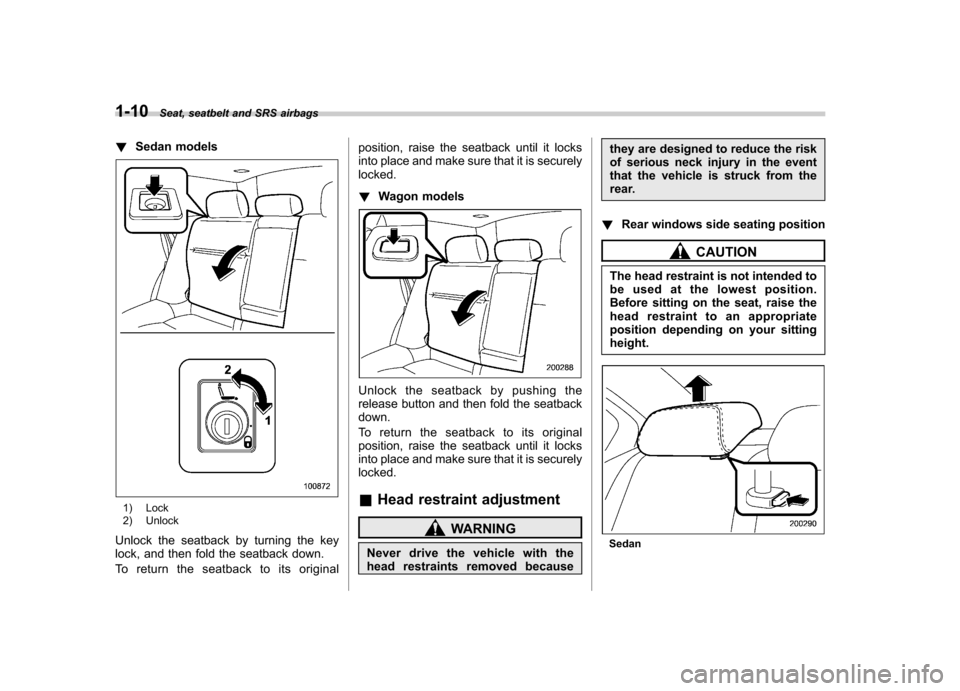
1-10Seat, seatbelt and SRS airbags
!Sedan models
1) Lock
2) Unlock
Unlock the seatback by turning the key
lock, and then fold the seatback down.
To return the seatback to its original position, raise the seatback until it locks
into place and make sure that it is securelylocked. !
Wagon models
Unlock the seatback by pushing the
release button and then fold the seatbackdown.
To return the seatback to its original
position, raise the seatback until it locks
into place and make sure that it is securelylocked. &Head restraint adjustment
WARNING
Never drive the vehicle with the
head restraints removed because they are designed to reduce the risk
of serious neck injury in the event
that the vehicle is struck from the
rear.
! Rear windows side seating position
CAUTION
The head restraint is not intended to
be used at the lowest position.
Before sitting on the seat, raise the
head restraint to an appropriate
position depending on your sittingheight.
Sedan
Page 38 of 442
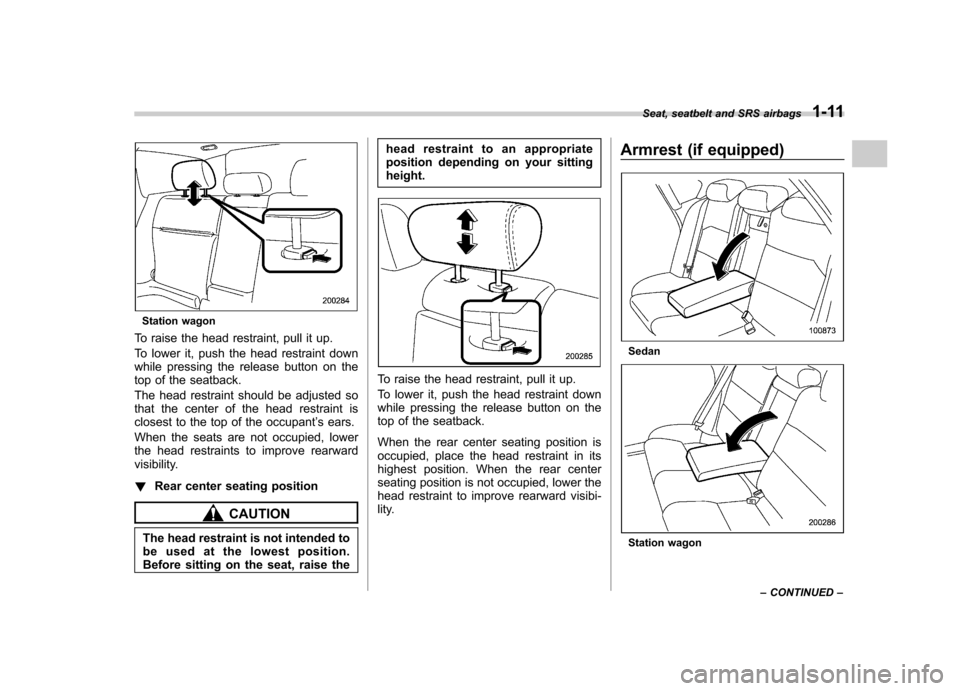
Station wagon
To raise the head restraint, pull it up.
To lower it, push the head restraint down
while pressing the release button on the
top of the seatback.
The head restraint should be adjusted so
that the center of the head restraint is
closest to the top of the occupant ’s ears.
When the seats are not occupied, lower
the head restraints to improve rearward
visibility. ! Rear center seating position
CAUTION
The head restraint is not intended to
be used at the lowest position.
Before sitting on the seat, raise the head restraint to an appropriate
position depending on your sittingheight.
To raise the head restraint, pull it up.
To lower it, push the head restraint down
while pressing the release button on the
top of the seatback.
When the rear center seating position is
occupied, place the head restraint in its
highest position. When the rear center
seating position is not occupied, lower the
head restraint to improve rearward visibi-
lity.
Armrest (if equipped)
Sedan
Station wagonSeat, seatbelt and SRS airbags
1-11
– CONTINUED –
Page 39 of 442
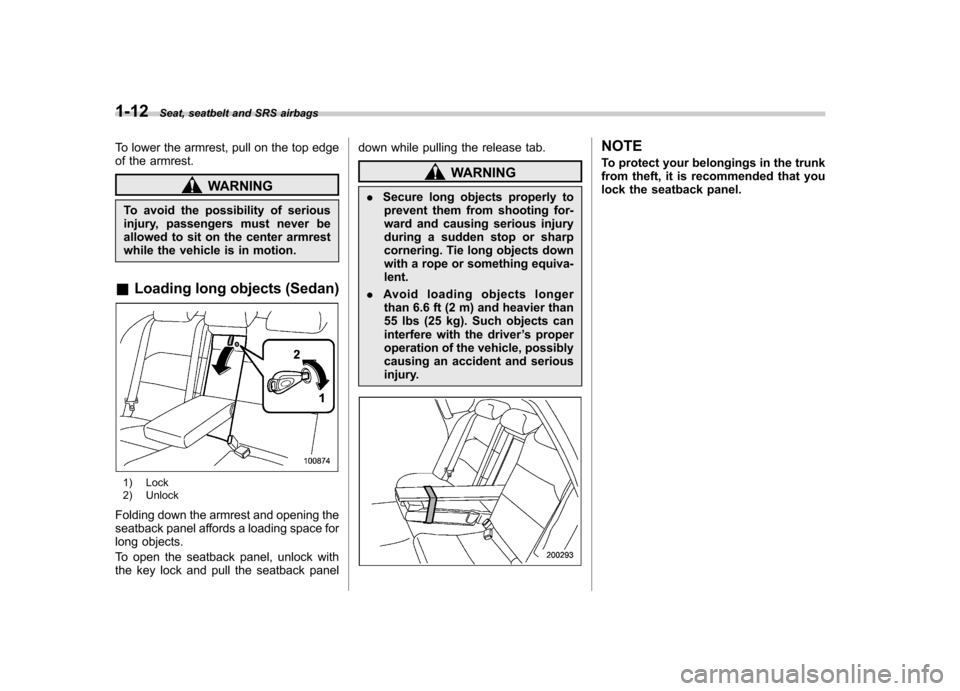
1-12Seat, seatbelt and SRS airbags
To lower the armrest, pull on the top edge
of the armrest.
WARNING
To avoid the possibility of serious
injury, passengers must never be
allowed to sit on the center armrest
while the vehicle is in motion.
& Loading long objects (Sedan)
1) Lock
2) Unlock
Folding down the armrest and opening the
seatback panel affords a loading space for
long objects.
To open the seatback panel, unlock with
the key lock and pull the seatback panel down while pulling the release tab.
WARNING
. Secure long objects properly to
prevent them from shooting for-
ward and causing serious injury
during a sudden stop or sharp
cornering. Tie long objects down
with a rope or something equiva-lent.
. Avoid loading objects longer
than 6.6 ft (2 m) and heavier than
55 lbs (25 kg). Such objects can
interfere with the driver ’s proper
operation of the vehicle, possibly
causing an accident and serious
injury.
NOTE
To protect your belongings in the trunk
from theft, it is recommended that you
lock the seatback panel.
Page 40 of 442
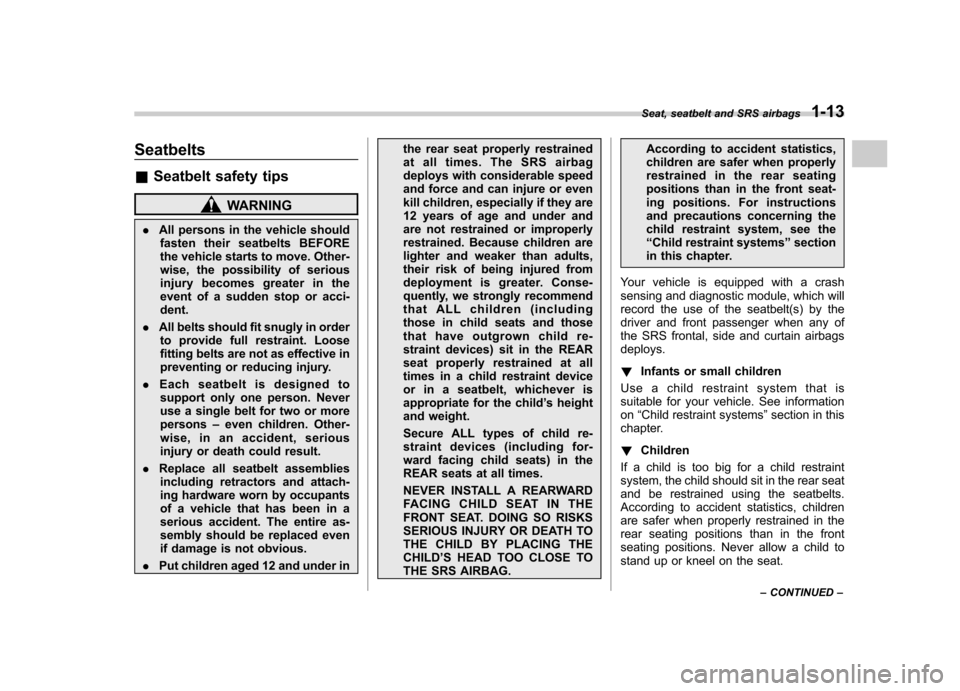
Seatbelts &Seatbelt safety tips
WARNING
. All persons in the vehicle should
fasten their seatbelts BEFORE
the vehicle starts to move. Other-
wise, the possibility of serious
injury becomes greater in the
event of a sudden stop or acci-dent.
. All belts should fit snugly in order
to provide full restraint. Loose
fitting belts are not as effective in
preventing or reducing injury.
. Each seatbelt is designed to
support only one person. Never
use a single belt for two or morepersons –even children. Other-
wise, in an accident, serious
injury or death could result.
. Replace all seatbelt assemblies
including retractors and attach-
ing hardware worn by occupants
of a vehicle that has been in a
serious accident. The entire as-
sembly should be replaced even
if damage is not obvious.
. Put children aged 12 and under in the rear seat properly restrained
at all times. The SRS airbag
deploys with considerable speed
and force and can injure or even
kill children, especially if they are
12 years of age and under and
are not restrained or improperly
restrained. Because children are
lighter and weaker than adults,
their risk of being injured from
deployment is greater. Conse-
quently, we strongly recommend
that ALL children (including
those in child seats and those
that have outgrown child re-
straint devices) sit in the REAR
seat properly restrained at all
times in a child restraint device
or in a seatbelt, whichever is
appropriate for the child
’s height
and weight.
Secure ALL types of child re-
straint devices (including for-
ward facing child seats) in the
REAR seats at all times.
NEVER INSTALL A REARWARD
FACING CHILD SEAT IN THE
FRONT SEAT. DOING SO RISKS
SERIOUS INJURY OR DEATH TO
THE CHILD BY PLACING THECHILD ’S HEAD TOO CLOSE TO
THE SRS AIRBAG. According to accident statistics,
children are safer when properly
restrained in the rear seating
positions than in the front seat-
ing positions. For instructions
and precautions concerning the
child restraint system, see the“
Child restraint systems ”section
in this chapter.
Your vehicle is equipped with a crash
sensing and diagnostic module, which will
record the use of the seatbelt(s) by the
driver and front passenger when any of
the SRS frontal, side and curtain airbagsdeploys. ! Infants or small children
Use a child restraint system that is
suitable for your vehicle. See informationon “Child restraint systems ”section in this
chapter. ! Children
If a child is too big for a child restraint
system, the child should sit in the rear seat
and be restrained using the seatbelts.
According to accident statistics, children
are safer when properly restrained in the
rear seating positions than in the front
seating positions. Never allow a child to
stand up or kneel on the seat. Seat, seatbelt and SRS airbags
1-13
– CONTINUED –